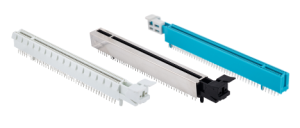What is PCIe and how does it work?
Introduction
Peripheral Component Interconnect Express (PCIe) is a high-speed interface standard crucial for connecting various hardware components within a computer system. As technology evolves, the need for faster data transfer rates and efficient communication between components has made PCIe increasingly important. This article will delve into what PCIe is, how it works, and its significance in modern computing, particularly focusing on the card edge design that facilitates these connections.
What is PCIe?
PCIe, short for Peripheral Component Interconnect Express, is a high-speed interface standard used for connecting components like graphics cards, storage devices, and network cards to a motherboard. Introduced in the early 2000s, PCIe has replaced older standards like PCI and AGP, providing a more efficient and versatile means of communication between hardware components.
PCIe operates on a point-to-point architecture, meaning each device has a dedicated connection to the motherboard. This design reduces latency and increases bandwidth, allowing for faster data transfer rates. The standard supports multiple lanes, which can be combined to create a higher bandwidth connection. Each lane consists of two pairs of wires, one for sending and one for receiving data, enabling simultaneous communication.
![]()
![]()
![]()

How PCIe Works
1. Architecture
At its core, PCIe utilizes a switch-based architecture. Unlike older technologies that relied on a shared bus, PCIe connects devices through switches that manage data traffic. This architecture allows multiple devices to communicate with the CPU and memory simultaneously, improving overall system performance.
2. Lanes and Bandwidth
PCIe connections are made up of lanes, with each lane consisting of two pairs of wires. The number of lanes can vary, with common configurations being x1, x4, x8, and x16. Each lane can support a theoretical maximum bandwidth, which has increased with the evolution of PCIe versions:
– **PCIe 1.0**: 2.5 GT/s (gigatransfers per second) per lane, equating to 250 MB/s.
– **PCIe 2.0**: 5 GT/s per lane, equating to 500 MB/s.
– **PCIe 3.0**: 8 GT/s per lane, equating to approximately 1 GB/s.
– **PCIe 4.0**: 16 GT/s per lane, equating to approximately 2 GB/s.
– **PCIe 5.0**: 32 GT/s per lane, equating to approximately 4 GB/s.
– **PCIe 6.0**: Expected to reach 64 GT/s per lane, providing a theoretical bandwidth of approximately 8 GB/s.
The ability to combine multiple lanes allows for high-performance devices, such as graphics cards, to utilize x16 configurations, offering significant bandwidth to meet the demands of modern applications.
3. Card Edge Connector
One of the essential aspects of PCIe is its card edge connector, which allows devices to be easily plugged into the motherboard. The card edge design plays a critical role in ensuring a secure and reliable connection between the PCIe device and the motherboard.
The card edge connector consists of a series of gold-plated contacts that align with corresponding pins on the motherboard. When a PCIe card is inserted into a slot, these contacts establish an electrical connection, enabling data transfer. The design of the card edge allows for easy installation and removal of devices, making it user-friendly for both consumers and professionals.
4. Data Transmission
PCIe uses a packet-based communication protocol to transmit data between devices. Each packet contains essential information, including the source and destination addresses, ensuring that data is sent to the correct location. The use of packets enhances efficiency, as multiple packets can be sent simultaneously across different lanes.
Additionally, PCIe employs a technology called “flow control” to manage data traffic. This mechanism ensures that devices do not overwhelm the connection with too much data at once, preventing data loss and maintaining optimal performance.
5. Compatibility and Scalability
PCIe is designed to be backward compatible, meaning newer versions of PCIe can work with older hardware. For example, a PCIe 4.0 device can operate in a PCIe 3.0 slot, albeit at the lower bandwidth of the older standard. This compatibility ensures that users can upgrade their systems without needing to replace all components.
Furthermore, PCIe’s scalability allows manufacturers to develop a wide range of devices that can take advantage of its high-speed capabilities. From graphics cards to SSDs and network adapters, the versatility of PCIe has made it the standard for modern computing.
Significance of PCIe in Modern Computing
The importance of PCIe in contemporary computing cannot be overstated. As applications become more demanding, the need for high-speed data transfer and efficient communication between components has grown. PCIe addresses these needs, making it a pivotal technology in various sectors, including gaming, data centers, and artificial intelligence.
1. Gaming
In the gaming industry, PCIe has revolutionized the performance of graphics cards. Modern GPUs leverage the high bandwidth provided by PCIe x16 connections, allowing them to deliver stunning graphics and smooth gameplay. As games become more graphically intensive, the demand for faster and more efficient data transfer continues to rise, making PCIe an essential component for gamers.
2. Data Centers
In data centers, PCIe plays a critical role in enhancing the performance of storage devices. NVMe (Non-Volatile Memory Express) drives utilize the PCIe interface to achieve ultra-fast data transfer rates, significantly improving read and write speeds compared to traditional SATA drives. This performance boost is crucial for applications that require quick access to large datasets, such as cloud computing and big data analytics.
3. Artificial Intelligence
The rise of artificial intelligence (AI) and machine learning has also highlighted the importance of PCIe. AI workloads often require massive amounts of data to be processed quickly, and the bandwidth provided by PCIe ensures that GPUs and other accelerators can communicate efficiently with the CPU and memory. As AI technology continues to advance, PCIe will remain a vital component in facilitating these developments.
Conclusion
PCIe has become the backbone of modern computing, providing a high-speed interface for connecting various hardware components. Its card edge design, scalable architecture, and compatibility make it an essential technology for gamers, data centers, and AI applications alike. As the demands for faster data transfer and efficient communication continue to grow, PCIe will undoubtedly play a crucial role in shaping the future of computing. Understanding PCIe and its workings not only helps consumers make informed decisions but also allows professionals to harness its capabilities for optimal performance in their systems.





